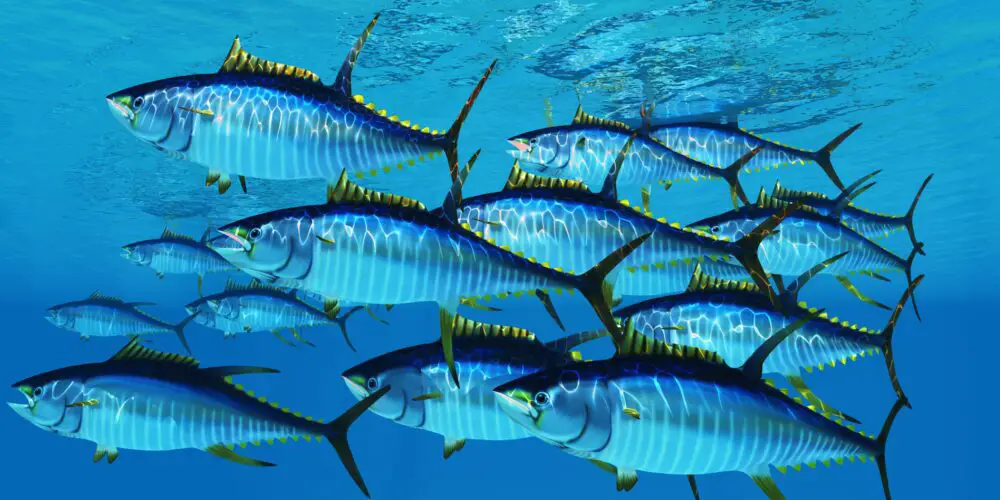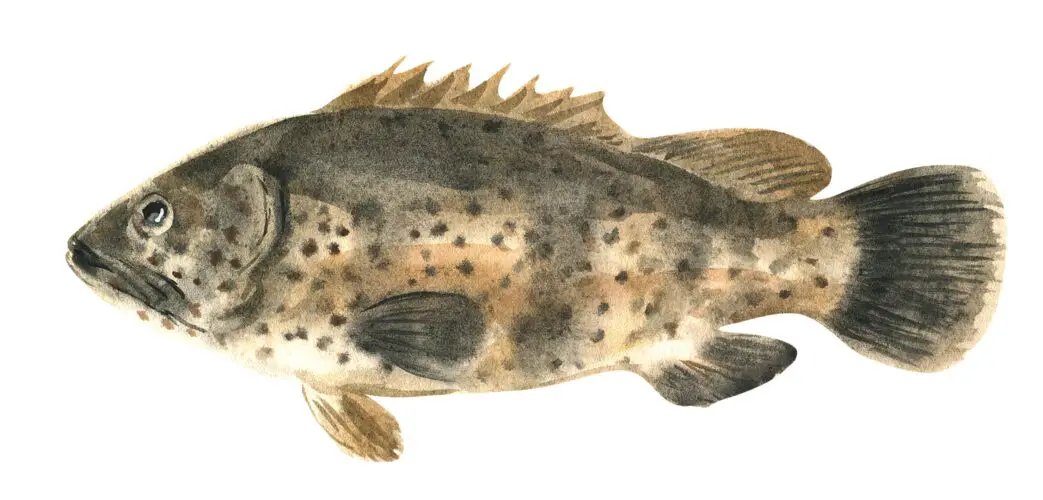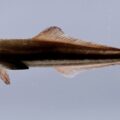In contrast to yellowfin tunas, groupers have giant mouths. While grouper muscles are white, yellowfin tuna muscles range from pink to dark red. More frequently than groupers, yellowfin tuna reside in the water column in self-made burrows.
Yellowfin Tuna
The yellowfin tuna is a significant fishery species and one of the fastest, most ferocious predators in the open ocean. The yellowfin tuna is a huge fish that can grow to weights of at least 400 pounds (190 kg) and lengths of about 7 feet (2 m), and it will consume almost anything that it can (typically whole). Like many open ocean bony fishes, yellowfin tunas are born as incredibly small larvae that are only a few millimeters long and weigh just a few hundredths of a gram. Individuals mature sexually and grow to a length of 3 feet (about one meter) in just two years.
Throughout its range, the yellowfin tuna is heavily fished because it is a highly valued food fish. Scientists believe that these fisheries are generally well-managed and that the species is well-fished. Nevertheless, some populations are targeted for fishing more frequently than others, and it is crucial to keep an eye on these operations to avoid reaching fishing quotas that might endanger this iconic, potent species.

Grouper
Groupers are a subfamily of fish called Epinephelinae. All members of this subfamily are groupers, and there are 159 species classified into 15 genera. Groupers have stout bodies and large mouths. Their massive bodies could reach more than a meter in length and weigh up to 100 kilograms. They only swim short distances. Groupers are predatory fish with a unique adaptation for capturing prey.
They can suck their prey animal by applying a powerful force through their mouth using gill muscles. Groupers do not bite their prey with teeth, but they can swallow it. The interesting thing about them is that they do not chase their prey but rather lie on the water and wait for it to suck into their mouth and swallow.

Yellowfin Tuna vs. Grouper Differences
A sizable portion of people prefer seafood in any form. As people acquire a taste for these fish, the flavor of all fish and other seafood generally varies. Your selected fish may vary depending on where you live and how near you are to the ocean. Cultural factors might also influence the kind of fish you eat. One has various choices and can pick from a vast range of fish that are offered in the market.
Due to several factors, including flavor and cost, some types are consumed more frequently than others. Domestically, tuna and grouper are two fish types that are frequently consumed. They both have good taste and are two of the market’s most popular fish. There are some key distinctions between the two.
-
- The way the user uses them is one of the biggest and most obvious distinctions. Before it is available to consumers, yellowfin tuna is often cooked and occasionally canned. On the other hand, groupers are typically sold live on the market, and no such preparation is made for them.
-
- Compared to yellowfin tuna, groupers have a taxonomic diversity that is more than three times larger.
-
- In contrast to yellowfin tuna, which frequently forms schools, groupers do not.
-
- While groupers cannot swim as quickly as yellowfin tuna can.
-
- Yellowfin tuna do not suckle their prey like groupers who wait for a passing target and then powerfully suck it into their mouths using their gill muscles.
-
- In contrast to yellowfin tuna, groupers have wide mouths.
-
- Unlike grouper, which has white muscles, yellowfin tuna has pink to dark red colored muscles.
-
- More frequently than groupers, yellowfin tuna reside in the water column in self-made burrows.
Nutrition Facts
Yellowfin Tuna
Yellowfin tuna provides 93 calories per 3-oz serving. 21 grams of protein and 0.42 grams of fat are both present in one serving. Less than 1% of the dietary value (DV) of a 2,000-calorie diet is represented by its 0.15 grams of saturated fat. Monounsaturated fat makes up 0.10 grams of this serving, while polyunsaturated fat makes up 0.13 grams. There is 33 mg, or 11% of the DV, of cholesterol. Carbohydrates, fiber, or sugar are not found in tuna.
Yellowfin tuna is considered to be a very lean and healthy fish. Yellowfin tuna is low in saturated fat and sodium, and the vitamins it is rich in are B6, B12, and phosphorus. If you are looking for a natural source of omega-3 fatty acids and some magnesium, this fish is a good option as it adds healthy benefits to your heart.
Grouper
Grouper is a great source of high-quality protein and other healthy fats, and it is low in saturated fat, which should make up no more than 10% of daily calories and which, if consumed in excess, can be harmful to the heart and arteries.
-
- Total Fat 1.1g. 2%
-
- Saturated Fat 0.3g. 1%
-
- Cholesterol 40mg. 13%
-
- Sodium 45mg. 2%
-
- Potassium 404mg. 12%
-
- Total Carbohydrates 0g. 0%
-
- Dietary Fiber 0g. 0%
-
- Protein 21g.
Facts to Know About Yellowfin Tuna
-
- Ahi tuna, commonly known as yellowfin tuna
-
- The dorsal, anal, and tail fins of the yellowfin tuna are a striking shade of yellow, giving them their name.
-
- When spawning, female yellowfin tuna species can release up to 4 million eggs.
-
- The maximum life span of this tuna species is seven years.
-
- Other fish species, such as skipjack and bigeye tuna, are known to migrate in schools alongside yellowfin tuna.
Facts to Know About Grouper
-
- Group Behavior- Solitary
-
- Prey- Other fish, sea turtles, small sharks, crustaceans, octopuses, and zooplankton
-
- Biggest Threat- Overfishing, habitat destruction
-
- Most Distinctive Feature- A robust body and a huge mouth
-
- Diet- Carnivore
-
- Lifespan– 11-50 years
-
- Length- between 10 to 12 inches and 8.2 feet
-
- Fun Fact- Many groupers can change their sex, which is always female to male.
Is grouper superior to yellowfin tuna?
Compared to grouper fish, yellowfish tuna has more of the vitamins B12, A RAE, B3, Phosphorus, Selenium, B2, B1, B6, B5, and Copper. Yellowfin tuna has a 428% higher daily requirement for vitamin B12. Grouper do not have the same amount of vitamin B2 as yellowfin tuna.
Conclusion
Groupers and yellowfin tuna are two important fish species that differ both externally and internally. Body types, swimming styles, feeding preferences, musculature, and a few physiological modifications separate these two-marine fish.











